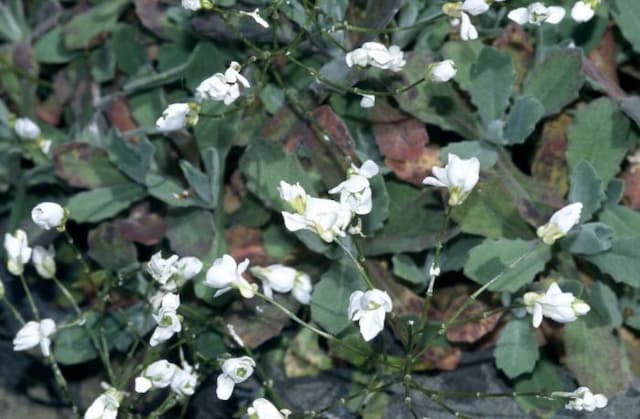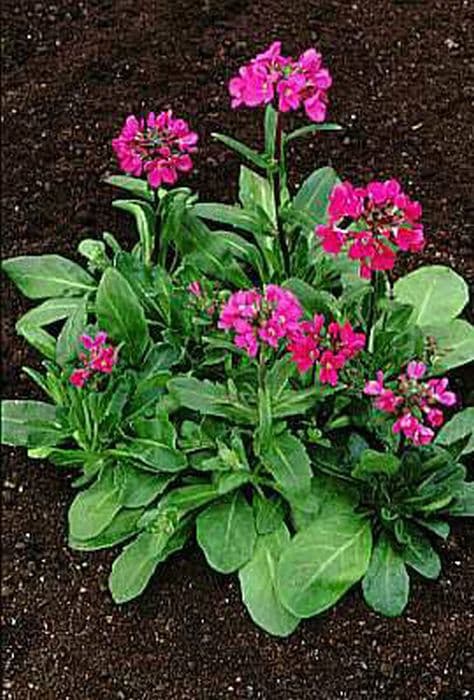Warley Rose Stonecress Aethionema 'Warley Rose'

ABOUT
Aethionema 'Warley Rose' is a charming perennial plant known for its appealing aesthetic and the splash of color it brings to gardens. It forms a low mound of blue-green foliage, which serves as a beautiful backdrop for its prominent attributes: the clusters of delicate pink flowers. These blossoms have a rounded shape and are arranged in dense clusters above the foliage, providing a vibrant display that can catch the eye. The leaves of this plant are small, narrow, and tend to be oblong or elliptical with a slightly fleshy texture, which is typical for plants that can endure dry conditions. The soft bluish-green tone of the foliage contrasts nicely with the bright pink of the flowers. This plant typically blooms in late spring to early summer, with the flowering season bringing forth a profusion of these charming pink flowers. The blooms are favored for their prolonged display and can bring life to rock gardens, borders, or any sunny spot in a landscape that appreciates a burst of color. Once the blooming period is over, the plant may produce seed pods that also have an ornamental quality. The structure of 'Warley Rose' is generally compact, with a neat and tidy habit, making it quite appealing for small spaces where every visual element counts. Overall, Aethionema 'Warley Rose' is admired for its combination of striking flowers, attractive foliage, and a neat, compact growth habit that makes it a delightful addition to a variety of garden settings.
About this plant
 Names
NamesFamily
Brassicaceae
Synonyms
Persian Candytuft, Warley Rose
Common names
Aethionema 'Warley Rose'.
 Toxicity
ToxicityTo humans
The stonecress plant is generally not considered toxic to humans. However, as with any plant, sensitivity can vary among individuals, and it is always advisable to avoid ingesting parts of ornamental plants as a precaution.
To pets
Stonecress is not known to be toxic to pets, but it's advisable to discourage pets from chewing on or ingesting this plant to prevent any possible gastrointestinal discomfort or more serious reactions in sensitive individuals.
 Characteristics
CharacteristicsLife cycle
Perennials
Foliage type
Evergreen
Color of leaves
Blue-green
Flower color
Pink
Height
1 foot (30 cm)
Spread
1 foot (30 cm)
Plant type
Shrub
Hardiness zones
5
Native area
Turkey
Benefits
 General Benefits
General Benefits- Ornamental Appeal: The plant features charming pink flowers that add color and aesthetic beauty to gardens and landscapes.
- Drought Tolerance: Aethionema 'Warley Rose' is known for being particularly drought tolerant, requiring minimal watering once established.
- Low Maintenance: This species typically requires less pruning and care compared to more high-maintenance plants.
- Attracts Pollinators: The flowers can attract butterflies and other beneficial pollinators, supporting local biodiversity.
- Rock Garden Suitability: With its compact growth habit, it works well in rock gardens or as groundcover.
- Cold Hardy: The plant is tolerant of cold temperatures, making it suitable for a variety of climates.
- Long Blooming Period: Aethionema 'Warley Rose' often has a lengthy flowering season, providing long-term visual interest.
- Deer Resistance: It is often resistant to deer, which can be beneficial in areas where deer browsing is a problem.
 Medical Properties
Medical PropertiesThis plant is not used for medical purposes.
 Air-purifying Qualities
Air-purifying QualitiesThis plant is not specifically known for air purifying qualities.
 Other Uses
Other Uses- Aethionema 'Warley Rose' can be used as a natural border for walkways and garden paths, creating a defined edge with its low-growing habit.
- In rock gardens, these plants excel by filling in crevices and providing a splash of color among the stones.
- Due to its compact nature, 'Warley Rose' can be planted in trough gardens, alongside succulents and alpines, for visual interest.
- This plant can be used in container gardens, where it brings delicate texture and soft pink blooms to patio displays.
- In slope and bank stabilization, Aethionema 'Warley Rose' helps to prevent soil erosion while adding aesthetic appeal.
- The flowers can be used in floral arrangements, particularly for those seeking a wild or rustic aesthetic.
- As a companion plant in vegetable gardens, 'Warley Rose' can provide a colorful foreground or backdrop to green veggies.
- 'Warley Rose' can be used as a living mulch, suppressing weeds while retaining soil moisture when planted densely.
- The plant's seeds can be collected and used as a teaching tool to demonstrate seed harvesting and germination processes in educational settings.
- Bonsai enthusiasts may utilize 'Warley Rose' for a unique floral bonsai, although it is an unconventional choice.
Interesting Facts
 Feng Shui
Feng ShuiThe Aethionema 'Warley Rose' is not used in Feng Shui practice.
 Zodiac Sign Compitability
Zodiac Sign CompitabilityThe Aethionema 'Warley Rose' is not used in astrology practice.
 Plant Symbolism
Plant Symbolism- Resilience: The Warley Rose, a type of Rock Cress, often grows in rocky, challenging environments, symbolizing the ability to thrive in tough conditions.
- Beauty in Adversity: Despite its rugged habitat, the Warley Rose has delicate pink flowers, representing the concept of finding beauty even in difficult circumstances.
- Endurance: As a perennial plant, the Warley Rose returns year after year, signifying endurance and the passage of time.
 Water
WaterPersian stonecress should be watered deeply but infrequently to encourage a strong root system. During the growing season, water with approximately one gallon per plant every week if there has been no significant rainfall. Adjust the amount of water depending on the weather conditions; reduce it during rainy periods and increase it during hot, dry spells. It's important to allow the soil to dry out between waterings to prevent root rot. Over winter, reduce watering significantly, only providing water if there is an extended dry spell, as the plant is dormant and requires less moisture.
 Light
LightPersian stonecress thrives in full sun exposure where it can receive at least six hours of direct sunlight daily. The ideal spot for this plant is in a south-facing garden that enjoys ample sunlight throughout the day. However, it can tolerate partial shade, especially in hotter climates where some respite from the intense afternoon sun can be beneficial.
 Temperature
TemperaturePersian stonecress prefers temperate conditions and can tolerate a range of temperatures but grows best when the daytime temperature is between 60°F and 75°F. This plant is hardy and can survive in temperatures as low as 0°F, making it suitable for many temperate climate gardens. To ensure optimal growth, protect it from extreme heat or cold, especially if the temperature drops below freezing for prolonged periods.
 Pruning
PruningPersian stonecress benefits from light pruning to promote healthy growth and a neat appearance. Pruning should be done in the early spring to remove any dead or damaged stems from the previous year. Cutting the plant back by about one-third after it has finished flowering can also encourage a second bloom. Regularly deadheading spent blooms throughout the flowering season can improve the plant's vigor and aesthetic appeal.
 Cleaning
CleaningAs needed
 Soil
SoilPersian Stonecress prefers well-drained soil mixed with grit or sand to enhance drainage, keeping it light and airy. The ideal pH for this plant is slightly alkaline, ranging from 7.0 to 7.5. Incorporate some compost for fertility, but avoid rich soils that retain moisture.
 Repotting
RepottingPersian Stonecress does not require frequent repotting and can often thrive in the same container for several years. It is typically repotted only when it has outgrown its current pot or when the soil needs refreshing, which is generally every 2 to 3 years.
 Humidity & Misting
Humidity & MistingPersian Stonecress thrives in environments with low to moderate humidity levels. They do not require high humidity and can tolerate dry air conditions, making them suitable for average home or garden environments.
 Suitable locations
Suitable locationsIndoor
Ensure bright light, good airflow, and low humidity for Persian Stonecress indoors.
Outdoor
Place Persian Stonecress in full sun with well-draining soil outdoors.
Hardiness zone
5-9 USDA
 Life cycle
Life cycleThe Warley Rose (Aethionema 'Warley Rose') begins its life cycle when the seeds germinate, typically in the spring, after experiencing a period of cold stratification that breaks their dormancy. It then enters the vegetative growth stage, where the plant develops its root system and foliage, forming a small, bushy perennial with grey-green leaves. As it matures, the Warley Rose produces dense clusters of pink or purplish flowers from late spring to early summer, attracting pollinators such as bees and butterflies. After pollination, the flowers develop into seed pods that eventually dry and release seeds, completing the reproductive stage. If conditions allow, the plant may then experience a period of dormancy, particularly in cooler climates, where it rests over the winter and resumes growth with the return of warmer temperatures. Some individual plants may live for several years, making the Warley Rose a short-lived perennial with a capability to self-seed and potentially establish new plants nearby.
 Propogation
PropogationPropogation time
Spring to summer
Propogation: Aethionema 'Warley Rose', commonly known as Persian Candytuft, is usually propagated by seed. The best time to sow seeds is in spring after the risk of frost has passed, or in autumn to allow the winter cold to stratify them naturally. To propagate, seeds should be sown in a well-draining soil mix, lightly covered, and kept moist until germination, which typically occurs within 14 to 30 days. Seedlings can then be grown on in cooler conditions until they are strong enough to be transplanted outdoors. This method is favored for its simplicity and effectiveness in producing new plants true to the parent.




![Aubrieta [Axcent Burgundy]](/_next/image?url=https%3A%2F%2Fplants-admin.emdemapps.com%2Fimages%2Fplants%2F%2Fimages%2F604b5b7b548d8.png&w=640&q=75)




